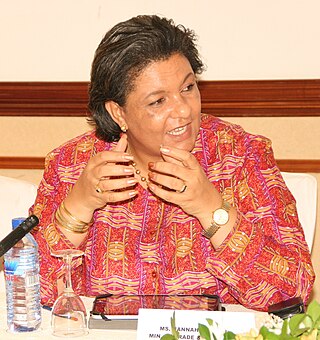Related Research Articles

Sex-selective abortion is the practice of terminating a pregnancy based upon the predicted sex of the infant. The selective abortion of female fetuses is most common where male children are valued over female children, especially in parts of East Asia and South Asia, as well as in the Caucasus, Western Balkans, and to a lesser extent North America. Based on the third National Family and Health Survey, results showed that if both partners, mother and father, or just the father, preferred male children, sex-selective abortion was more common. In cases where only the mother prefers sons, this is likely to result in sex-selective neglect in which the child is not likely to survive past infancy.
Sociosexuality, sometimes called sociosexual orientation, is the individual difference in the willingness to engage in sexual activity outside of a committed relationship. Individuals who are more restricted sociosexually are less willing to engage in casual sex; they prefer greater love, commitment and emotional closeness before having sex with romantic partners. Individuals who are more unrestricted sociosexually are more willing to have casual sex and are more comfortable engaging in sex without love, commitment or closeness.
Sex selection is the attempt to control the sex of the offspring to achieve a desired sex. It can be accomplished in several ways, both pre- and post-implantation of an embryo, as well as at childbirth. It has been marketed under the title family balancing.

Immigration is the international movement of people to a destination country of which they are not usual residents or where they do not possess nationality in order to settle as permanent residents. Commuters, tourists, and other short-term stays in a destination country do not fall under the definition of immigration or migration; seasonal labour immigration is sometimes included, however.
Childhood gender nonconformity (CGN) is a phenomenon in which prepubescent children do not conform to expected gender-related sociological or psychological patterns, or identify with the opposite sex/gender. Typical behavior among those who exhibit the phenomenon includes but is not limited to a propensity to cross-dress, refusal to take part in activities conventionally thought suitable for the gender and the exclusive choice of play-mates of the opposite sex.
Son preference is the ancient and cross-cultural human preference for male offspring. Son preference has been demonstrated across all social classes, from "succession laws in royal families to land inheritance in peasant families." Sons are considered both a status symbol and a genetic and economic competitive advantage.

The status of women in Ghana and their roles in Ghanaian society has changed over the past few decades. There has been a slow increase in the political participation of Ghanaian women throughout history. Women are given equal rights under the Constitution of Ghana, yet disparities in education, employment, and health for women remain prevalent. Additionally, women have much less access to resources than men in Ghana do. Ghanaian women in rural and urban areas face slightly different challenges. Throughout Ghana, female-headed households are increasing.

Women in South Korea have experienced significant improvements for social changes in recent years, compared to previous times, when Confucianism was deeply imbued in the culture. The economy of South Korea has tremendously improved due to urbanisation, industrialisation, military authoritarianism, democratic reform, and social liberalisation since the late 1960s. Gender roles and gender identities have been modified in response to modernity. More than half of Korean women are employed. In a 2018 OECD economy survey, it was 56.1%. It is lower than OECD average. More than 25% of married women are employed as full-time workers.

Women in Nigeria are a diverse group of individuals who have a wide range of experiences and backgrounds. They are mothers, daughters, sisters, wives, entrepreneurs, professionals, and activists. Women in Nigeria face numerous challenges, including gender inequality, poverty, and a lack of access to education and healthcare. Despite these challenges, Nigerian women are making strides in all areas of life and are becoming increasingly empowered to take control of their lives and their futures.

The term "missing women" indicates a shortfall in the number of women relative to the expected number of women in a region or country. It is most often measured through male-to-female sex ratios, and is theorized to be caused by sex-selective abortions, female infanticide, and inadequate healthcare and nutrition for female children. It is argued that technologies that enable prenatal sex selection, which have been commercially available since the 1970s, are a large impetus for missing female children.

In the psychology of color, color preferences are the tendency for an individual or a group to prefer some colors over others, such as having a favorite color or a traditional color.
The World Health Organization (WHO) has defined health as "a state of complete physical, mental, and social well-being and not merely the absence of disease or infirmity." Identified by the 2012 World Development Report as one of two key human capital endowments, health can influence an individual's ability to reach his or her full potential in society. Yet while gender equality has made the most progress in areas such as education and labor force participation, health inequality between men and women continues to harm many societies to this day.

Women's health in India can be examined in terms of multiple indicators, which vary by geography, socioeconomic standing and culture. To adequately improve the health of women in India multiple dimensions of wellbeing must be analysed in relation to global health averages and also in comparison to men in India. Health is an important factor that contributes to human wellbeing and economic growth.
In South Korea, gender inequality is derived from deeply rooted patriarchal ideologies with specifically defined gender-roles. While it remains especially prevalent in South Korea's economy and politics, gender inequality has decreased in healthcare and education.

The gender pay gap or gender wage gap is the average difference between the remuneration for men and women who are working. Women are generally found to be paid less than men. There are two distinct numbers regarding the pay gap: non-adjusted versus adjusted pay gap. The latter typically takes into account differences in hours worked, occupations chosen, education and job experience. In the United States, for example, the non-adjusted average woman's annual salary is 79–83% of the average man's salary, compared to 95–99% for the adjusted average salary.
Gender roles are culturally influenced stereotypes which create expectations for appropriate behavior for males and females. An understanding of these roles is evident in children as young as age four. Children between 3 and 6 months can form distinctions between male and female faces. By ten months, infants can associate certain objects with females and males, like a hammer with males or scarf with females. Gender roles are influenced by the media, family, environment, and society. In addition to biological maturation, children develop within a set of gender-specific social and behavioral norms embedded in family structure, natural play patterns, close friendships, and the teeming social jungle of school life. The gender roles encountered in childhood play a large part in shaping an individual's self-concept and influence the way an individual forms relationships later on in life.
For years, the census data in China has recorded a significant imbalance sex ratio toward the male population, meaning there are fewer women than men. This phenomenon is sometimes referred to as the missing women or missing girls of China. In 2021, the male-to-female ratio of China is recorded at 104.61 to 100.
Gender inequality in Nepal refers to disparities and inequalities between men and women in Nepal, a landlocked country in South Asia. Gender inequality is defined as unequal treatment and opportunities due to perceived differences based solely on issues of gender. Gender inequality is a major barrier for human development worldwide as gender is a determinant for the basis of discrimination in various spheres such as health, education, political representation, and labor markets. Although Nepal is modernizing and gender roles are changing, the traditionally patriarchal society creates systematic barriers to gender equality.
Lisa Cameron is an Australian economist currently working as a Professional Research Fellow at the Melbourne Institute of Applied Economic and Social Research at the University of Melbourne.

Gender disappointment is the feeling of sadness parents experience when the desire for a child of a preferred sex is not met. It can create feelings of shame which cannot always be expressed openly. It is often noticed in cultures where women are viewed as of a lower status and the preferred choice is for a male infant, i.e. son preference. It may result in sex-selective killing, or the neglection of female children.
References
- ↑ Fuse, Kana (2013-05-17). "Daughter preference in Japan: A reflection on gender role attitudes?". Demographic Research. 28: 1021–1052. doi: 10.4054/DemRes.2013.28.36 . ISSN 1435-9871.
- ↑ Duan, Huiqiong; Hicks, Daniel L. (2020-08-17). "New evidence on son preference among immigrant households in the United States". IZA Journal of Development and Migration. 11 (1): 20200014. doi: 10.2478/izajodm-2020-0014 . ISSN 2520-1786. S2CID 221257460.
- ↑ Chun, Heeran; Das Gupta, Monica (2022-05-04). "'Not a bowl of rice, but tender loving care': from aborting girls to preferring daughters in South Korea". Asian Population Studies. 18 (2): 169–189. doi: 10.1080/17441730.2021.1944408 . ISSN 1744-1730. S2CID 240698960.
- ↑ Abramishvili, Zurab; Appleman, William; Maksymovych, Sergii (2019-09-05). "Parental Gender Preference in the Balkans and Scandinavia: Gender Bias or Differential Costs?". Rochester, NY. doi:10.2139/ssrn.3448492. S2CID 203078609. SSRN 3448492.
{{cite journal}}: Cite journal requires|journal=(help) - ↑ Krishnan, Vijaya (July 1987). "Preferences for sex of children: a multivariate analysis". Journal of Biosocial Science. 19 (3): 367–376. doi:10.1017/S0021932000017004. ISSN 0021-9320. PMID 3624297. S2CID 7285614.
- ↑ Smith-Greenway, Emily; Weitzman, Abigail. "Investigating Daughter Preference in a Matrilineal Context" (PDF).
- ↑ Le, Kien; Nguyen, My (2022-03-01). "Son preference and health disparities in developing countries". SSM - Population Health. 17: 101036. doi:10.1016/j.ssmph.2022.101036. ISSN 2352-8273. PMC 8804262 . PMID 35128024.